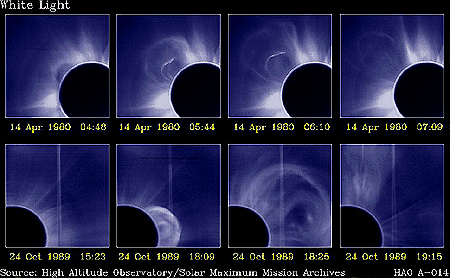
Coronal Mass Ejections,
Solar Flares, and the
Sun-Earth Connection
The above image shows two examples of a coronal mass ejection (CME). The black disk blocks out the bright light from the Sun, creating an artificial eclipse so that the dim light from the CME can be observed. (The disk blocks out light from a region that is 1.6 times the diameter of the Sun.) Each row shows the evolution of a CME with time. Coronal mass ejections expand away from the Sun at speeds as high as 2000 km per second. They carry up to ten billion tons (1016 grams) of plasma away from the Sun.
Coronal mass ejections were once thought to be initiated by solar flares. Although most are accompanied by flares, it is now understood that flares and CMEs are related phenomena, but one does not cause the other. This has important implications for understanding and predicting the effects of solar activity on the Earth and in space. If a CME collides with the Earth, it can excite a geomagnetic storm. Large geomagnetic storms have, among other things, caused electrical power outages and damaged communications satellites. In space CMEs typically drive shock waves that produce energetic particles that can be damaging to both electronic equipment and astronauts that venture outside the protection of the Earth's magnetic field. Solar flares, on the other hand, directly affect the ionosphere and radio communications at the Earth, and also release energetic particles into space. Therefore, to understand and predict "space weather" and the effect of solar activity on the Earth, an understanding of both CMEs and flares is required.
A recent coronal mass ejection and subsequent geomagnetic storm have been observed in unprecedented detail thanks to the International Solar-Terrestrial Physics (ISTP) Program. No solar flare was observed in association with this CME. An AT&T communications satellite, Telstar 401, malfunctioned during the geomagnetic storm. The following Web site is devoted to the study of this event:
![]() The January 6-11, 1997, Coronal
Mass Ejection Event
The January 6-11, 1997, Coronal
Mass Ejection Event
The even more recent April 7, 1997, event did have a modest solar flare associated with it. More information is available at the following site:
![]() The April 7, 1997, Coronal Mass
Ejection and Solar Flare
The April 7, 1997, Coronal Mass
Ejection and Solar Flare
![]() Why did 45 million people
temporarily lose their pager service in May, 1998?
Why did 45 million people
temporarily lose their pager service in May, 1998?
![]() View an MPEG (478 K) movie
of a Sun-grazing comet and a CME. The two events are in sequence, but are unrelated. The
movie was obtained with the Large Angle and Spectrometric Coronagraph (LASCO) on
the Solar and Heliospheric Observatory (SOHO). SOHO is a project of international
cooperation between the European Space Agency (ESA) and NASA.
View an MPEG (478 K) movie
of a Sun-grazing comet and a CME. The two events are in sequence, but are unrelated. The
movie was obtained with the Large Angle and Spectrometric Coronagraph (LASCO) on
the Solar and Heliospheric Observatory (SOHO). SOHO is a project of international
cooperation between the European Space Agency (ESA) and NASA.
![]() Visit the SOHO Web site. Many more images and movies
of the Sun can be found here, including coronal mass ejections.
Visit the SOHO Web site. Many more images and movies
of the Sun can be found here, including coronal mass ejections.
![]() Images of another CME and more
about the two CMEs shown above
Images of another CME and more
about the two CMEs shown above
![]() "New Findings Challenge
Beliefs about Solar-Terrestrial Physics" by J. T. Gosling - A 1993 article from Eos,
the Proceedings of the American Geophysical Union.
"New Findings Challenge
Beliefs about Solar-Terrestrial Physics" by J. T. Gosling - A 1993 article from Eos,
the Proceedings of the American Geophysical Union.
 TRY
THIS! Estimate the speed and acceleration of a coronal mass ejection using SOHO
images.
TRY
THIS! Estimate the speed and acceleration of a coronal mass ejection using SOHO
images.
![]()
![]() Next: Space Weather - What impact do solar flares have on human activities?
Next: Space Weather - What impact do solar flares have on human activities?
![]() Why Study Solar Flares?
Why Study Solar Flares?
![]() Solar Flare
Homepage
Solar Flare
Homepage
![]() Table of Contents
Table of Contents
Responsible NASA Official: Gordon D. Holman
Heliophysics Science Division
NASA/Goddard Space Flight Center
Solar Physics Laboratory / Code 671
Greenbelt, MD 20771, USA
Gordon.D.Holman@nasa.gov